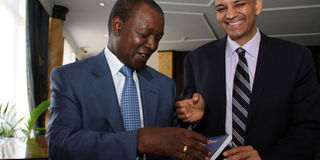Diversify exports to speed up growth, World Bank advises

PHOTO | DIANA NGILA CBK governor Prof Njuguna Ndung’u with World Bank lead economist Apurva Sanghi during the World Bank policy notes themed ‘Achieving Shared Prosperity in Kenya’ launched in Nairobi on October 29, 2013.
What you need to know:
- Between 2003 and 2011, 78 per cent of GDP growth in Kenya came from private consumption expenditure
- In order to achieve the objective of double digit growth in five years, the World Bank says, Kenya will have to re-evaluate the policies that have resulted in this imbalance
Kenya will have to stop relying heavily on domestic consumption to grow its economy if it hopes attain growth targets outlined in the country’s development blue-print, Vision 2030, a new report says.
The report released by World Bank on Tuesday notes that growth in Kenya has been largely driven by high consumption. On the other hand, the Kenya’s exports have performed poorly while investment levels have been underwhelming.
“Going forward, Kenya will need to rebalance the sources of growth so that it relies less on current domestic consumption, and more on investments and diversified exports,” reads the report in part.
Between 2003 and 2011, 78 per cent of GDP growth in Kenya came from private consumption expenditure which was matched by a rapid rise in the country’s imports.
The country’s share of world merchandise exports, on the other hand, has shrunk by 75 per cent since 1960s resulting in slower GDP growth.
Driving the economy on consumption has led to relative underperformance in key economic indicators. Over the last ten years, the World Bank says, Kenya’s economic growth has been erratic and has lagged behind peers in Sub-Saharan Africa.
“Compared to its peers, Kenya’s economic performance is less stellar than it should be. It is underperforming,” said the Bank’s lead private sector development specialist, Mr Ganesh Rasagam.
Between 2000 and 2010, Kenya grew an average 3.8 per cent in comparison to the Sub Saharan Africa average of 5.5 per cent.
While some of this underperformance could be attributed to election-related turmoil, Mr Rasagam noted that there are fundamental imbalances in the economy that need to be addressed.
In order to achieve the objective of double digit growth in five years, the World Bank says, Kenya will have to re-evaluate the policies that have resulted in this imbalance.
In exports, the country will need to diversify both the commodities that it exports and the markets that it targets. Currently, Kenya still relies primarily on the European Union to absorb its agricultural commodities.
Lessons from the European economic crisis indicate that this is not sustainable. Emerging markets and other markets in the continent are suggested as alternatives to the EU that Kenya needs to consider.
Fundamentally, the country needs to invest heavily in the manufacturing and agriculture sectors which are key to export growth but which have remained relatively neglected.
PROVIDE INCENTIVES
In manufacturing, the government has been urged to improve the operating environment and to provide incentives for investment in the sector. These reforms will essentially kill two birds with one stone by also making it easier for Kenya to attract higher levels foreign direct investment.
Policy reforms in agriculture ought to make it easier for farmers to access markets. Regulation that will revamp the government agencies in the sector and establish one over-arching authority should be implemented.
In particular, the World Bank notes that there is dire need to reform the National Cereal and Produce Board (NCPB) to increase transparency. Further, private sector players ought to be given a larger space in this sub-sector.
The Bank also encouraged the establishment of a commodities exchange in Nairobi that will link farmers to the market.
Currently, Rwanda is in the early stages of establishing a regional commodities exchange. Kenya is also drafting legislation that would pave the way for a commodities exchange in Nairobi.





